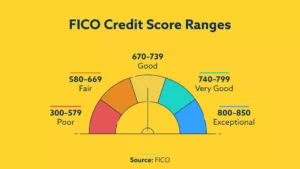When I purchased my first home credit scores were the furthest thing from my mind. I had saved a down payment and was ready to buy – so I thought. While my scores were decent, they were not perfect.
I had several credit cards with high utilization and at the time did not realize how much that was affecting my credit scores. I wanted the lowest interest rate which would save me thousands of dollars over the lifetime of the loan but the credit union would not budge. Finally an underwriter let me in on a secret…lower your balances and your credit scores will go up. It worked!
With a little testing, trial and error, I was able to raise my credit score to a number that gave me the credit union’s lowest interest rate on a 30-year mortgage. It took me about 3 months but these tips can work in as little as 30 days for some.
Here are my Steps:
1. Check Credit Reports
Order your current credit reports from the 3 major credit bureaus. Mortgage lenders always run all three credit reports and use your middle score as a basis for their decision about your application and what interest rate they will offer.
Annualcreditreport.com offers your free credit reports every 12 months. In most cases you can order, view and print them right online. If not, you may need to provide each credit bureau documents proving your identity and wait 15 days or less to get your reports through the mail.
2. Check FICO Scores
There are currently over 20 web sites offering free credit scores. But unless you order your FICO scores from myfico.com or you get a free FICO score through your credit card provider, those web sites are not offering your real credit score. Knowing the FICO scores used by lenders will give you a better idea of where you stand before you apply. If you find errors it is better to have them corrected before you submit an application.
3. Find out when Creditors Report
Know what date your creditors update payment information to your credit reports. Most creditors typically report to each bureau monthly; although it’s not always on the same date for each credit bureau. You can easily determine your reporting date by looking at your statement.
Generally creditors will report to the credit bureaus after a new statement is generated. For instance your due date may be on the 15th of the month. After you pay your bill a few days later a new statement will be cut and on that date creditors typically report your payment and new balance to the credit bureaus. However, it may take the credit bureaus several days to actually update your credit reports with the new information.
4. Pay down credit cards to 2% utilization
Once I knew when my creditors reported payment and balance information to the credit bureaus I paid off my credit cards. About a week later I ordered my FICO scores. To my surprise my credit scores decreased once I had no revolving credit card debt. What the heck!
It seemed the FICO scoring model did not like zero revolving debt. I then charged about $250 on two of the credit cards and left the other four at zero balance. After the 2nd month went by I got new statements with the new balance on each of the cards.
I then paid the 2 credit cards down to 2 percent utilization leaving about $150.00 balance on each credit card. By the 3rd month after the 2 percent utilization was reported by the creditors, my FICO scores shot up by over 80 points! It took me approximately 3 months of testing credit utilization but it was worth the results.
Credit utilization is 30% of your credit score. That’s a big chunk in determining a credit score. Utilization refers to revolving debt (credit cards). It is also known as “debt-to-limit ratio” and measures the amount of your revolving credit limits that you are currently using.
Utilization is really important and is calculated on both your individual revolving accounts as well as on the total credit limits and balances of all revolving accounts appearing on a credit report.
I would suggest first decreasing your balances to 10 percent or less of your available credit limits. See if there is a change in score. Then decreasing to 7 percent of your available credit limits and see what your score is at that point. You may have to tweak it a little to discover at what percent utilization your best scores reside.
5. Raise your credit limits
Once I discovered the importance of utilization and played around with it for 3 months, I requested credit line increases. That way I could pump up my spending ability while staying as close to 2 percent utilization as possible. One credit card issuer doubled my credit limit granting a new credit line of $15,000. I was then able to carry a balance of $300 while still maintaining a 2 percent utilization rate.
Your credit scores may react to credit utilization differently but it is a good strategy to maintain a low utilization. FICO says consumers with the highest credit scores are using an average of 7% of their available credit.
Increasing credit scores is different for every consumer so need to play around with utilization to determine where your best scores exist.
Long story short – I got my home at the best mortgage rate the credit union had to offer.

















